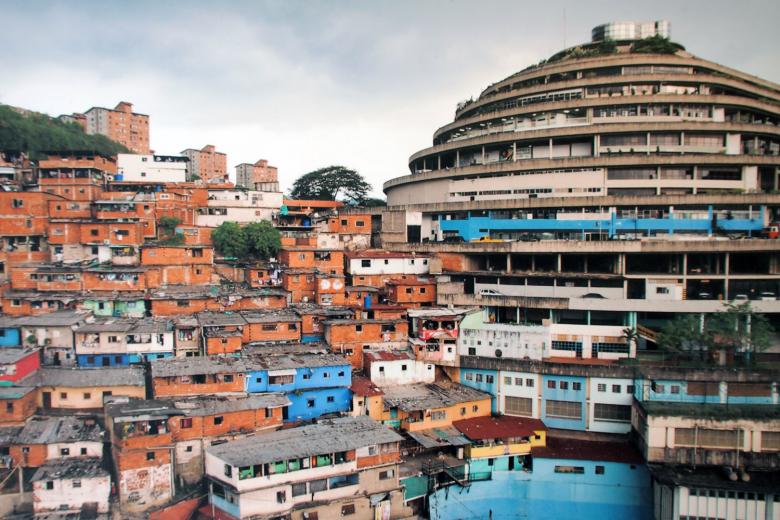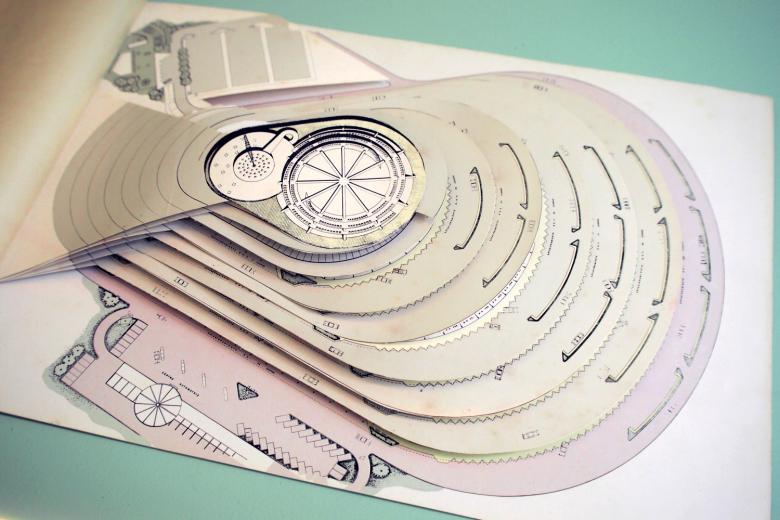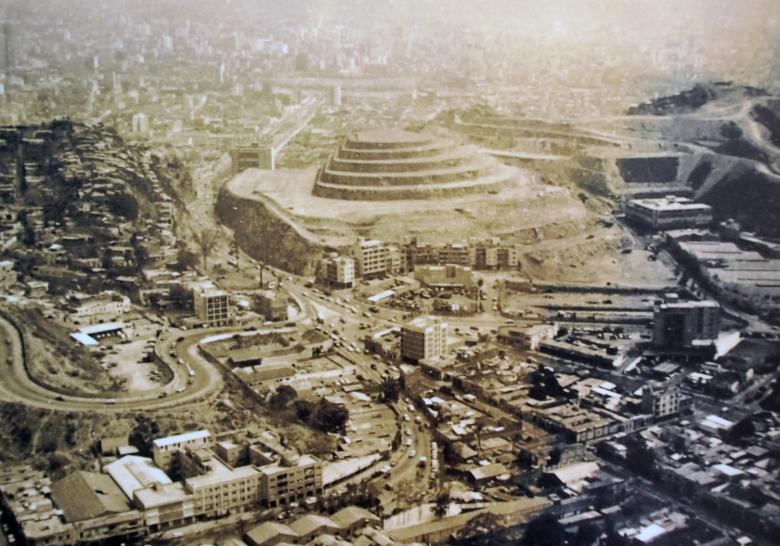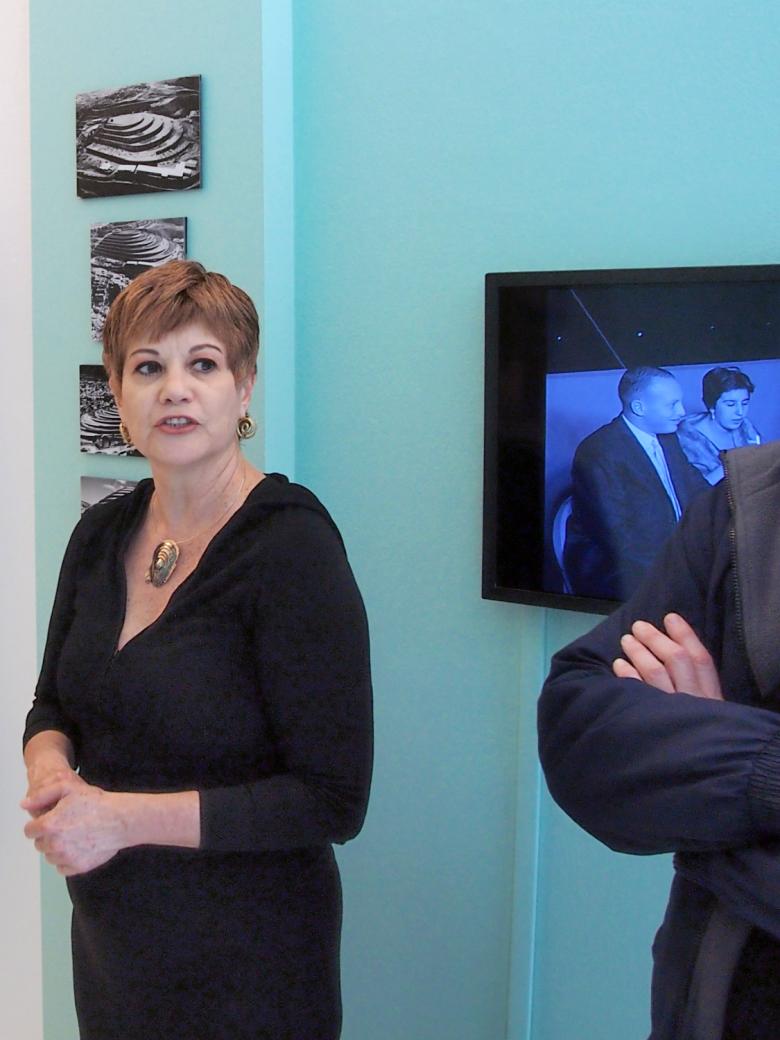Caracas's 'Living Ruin'
El Helicoide de la Roca Tarpeya, a spiraling mall designed by Venezuelan architect Jorge Romero Gutiérrez in the late 1950s, is the subject of an exhibition and forthcoming book that trace its evolution into a current-day prison. World-Architects attended a tour by curator/editor Celeste Olalquiaga at the Center for Architecture to learn about the fascinating project.
Although only a small, one-room exhibition, El Helicoide: From Mall to Prison (and its companion book, From Mall to Prison: El Helicoide's Downward Spiral, to be published by Urban Research in July) is an ambitous undertaking that brings an overlooked piece of avant-garde architecture – albeit a failed one – to the attention of a wider audience. The exhibition presents photographs of El Helicoide under construction, shortly after its completion and abandonment, and in its current state, alongside original artifacts (banners, brochures, drawings, and models), videos, and proposals reimagining the project's future. The exhibition and book are the product of Olalquiaga's non-profit Proyecto Helicoide, which is "dedicated to rescuing the architectural, cultural and social value of El Helicoide."
The story of El Helicoide starts in the late 1950s, when architect Gutiérrez proposed a futuristic hilltop mall with a 2.5-mile "endless" ramp for cars to ascend, descend, and park in front of the shops they wanted to visit. The project also included a dome designed by R. Buckminster Fuller and landscaping designed by Roberto Burle Marx. Although created during a Venezuelan dictatorship, the project was purely a private venture, one where the shop owners paid for their spaces in advance to fund the construction. Yet when democracy entered the country in 1960, the new government opted to disassociate itself from the project that they associated with the dictatorship, so it cut off funding. This led to the project's halting in 1961, the same year the Museum of Modern Art in New York included El Helicoide in Roads, an exhibition curated by Bernard Rudofsky that presented " a wholly new kind of [road-inspired] architecture." So just as Gutiérrez's project was becoming known internationally, at home it was stymied for political reasons.
Following the halt of El Helicoide, the developers sued the government and in turn the shop owners sued the developers. Nelson Rockefeller, who was doing business with oil-rich Venezuela around this time, tried to buy the project, but as Olalquiaga told us, "he could not cut across the red tape." So in the 1970s, as the barrios grew around the project's hilltop site, the developer lost their lawsuit and El Helicoide passed to the state. Proposals for commercial, cultural, and mixed-use centers followed, but none of them moved beyond the drawing board. The first reuse didn't happen until 1979, when 500 families that were victicms of mudslides were housed in containers in the building. According to Olalquiaga, at this time the project moved from "a white elephant to a 'red zone,' an urban problem with crime, corruption, drugs, everything happening there and affecting the communities around it."
By 1982 the number of people occupying El Helicoide had ballooned to 10,000, at which time they were peacefully evicted, to be replaced by a Museum of History and Anthropology. Although that project successfully replaced the geodesic dome – it had been in storage for twenty years – atop the building, the museum never happened due to another change of government. The new administration decided El Helicoide could be used for better things, so in 1985 the police took over the two lowest levels for their intelligence department. Seven years later came a progressive proposal to house a Department of Renewable Energy at the top of the building, but just then the opposition party came to power and halted that project, giving the refurbished spaces at the top to the police. So in 1992 El Helicoide was in effect a "sandwich": police at the top and bottom with nothing in between.
Hugo Chavéz, who became President of Venezuela in 1999, wanted to create a refuge for homeless children in El Helicoide, but, like earlier proposals, that didn't happen either, leading him to call the place "cursed." Instead, Chavéz's Bolivarian Revolution moved his police forces into the building and converted spaces near the bottom of the building into a jail – an illegal prison where torture is carried out to this day. Olalquiaga recounted that the Inter-American Court on Human Rights examined the facilities in 2012 and concluded they were not fit to be a prison. Nevertheless, this is where students protesting as recently as 2014 have been taken and detained illegally. To this day the middle levels remain primarily empty, making it "a living ruin" to Olalquiaga.
During the tour, Olalquiaga described El Helicoide as "a metaphor for what has happened in Venezuela in the last sixty years ... an enthusiastic, ambitious project of consumption that went in a downward spiral." This metaphor recalls Torre David, also in Caracas; the "slumscraper" was built in the 1990s as a downtown office tower, left unfinished during the 1994 financial crisis, and then subsequently occupied by squatters. Known widely through a 2013 book with photos by Iwan Baan and an award-winning exhibition at the 2012 Venice Biennale, the design of Torre David is not nearly as ambitious architecturally as the earlier El Helicoide, which deserves to be just as well known to people outside of Venezuela.
Similar to Torre David, which sits empty following the evictions of the squatters, the future of El Helicoide is uncertain. El Helicoide: From Mall to Prison features a number of proposals for the hilltop building, but they are primarily critiques rather than serious potential futures. (One shows the building taken over by the adjacent barrios, while another envisions its destruction.) If Olalquiaga and her compatriots at Proyecto Helicoide have their way, that future would at least be optimistic – the project would be seen as a place with potential born from its avant-garde roots, not a place of stigma born from its political failures.








